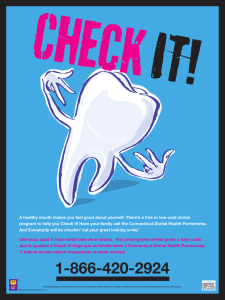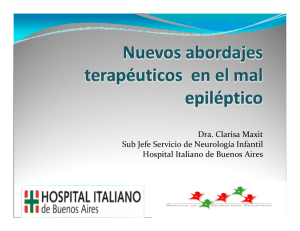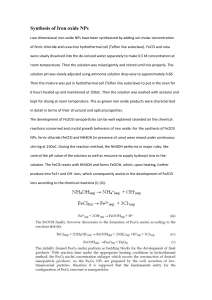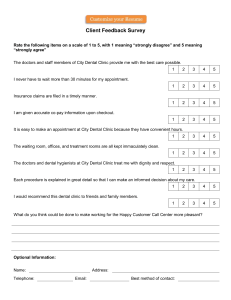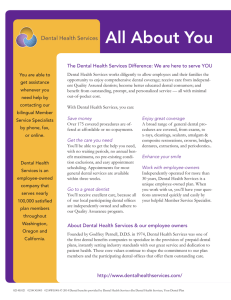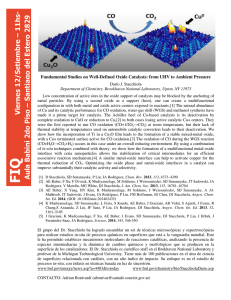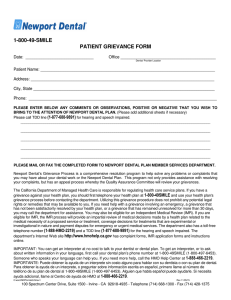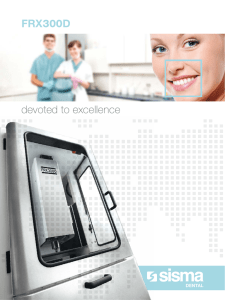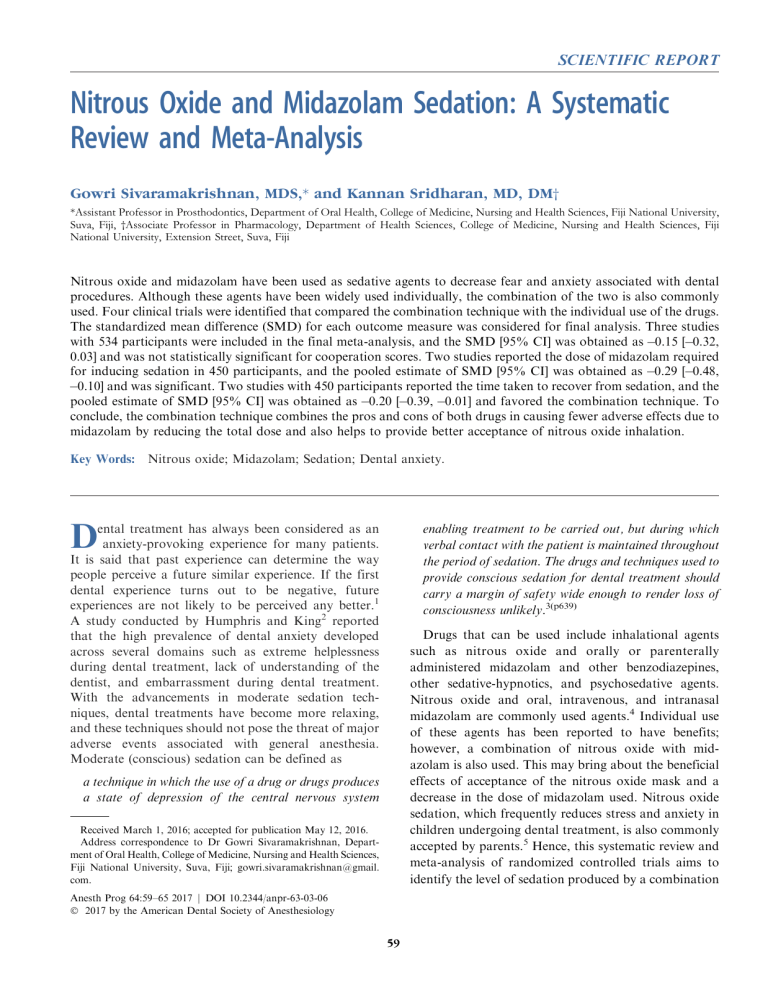
SCIENTIFIC REPORT Nitrous Oxide and Midazolam Sedation: A Systematic Review and Meta-Analysis Gowri Sivaramakrishnan, MDS,* and Kannan Sridharan, MD, DM† *Assistant Professor in Prosthodontics, Department of Oral Health, College of Medicine, Nursing and Health Sciences, Fiji National University, Suva, Fiji, †Associate Professor in Pharmacology, Department of Health Sciences, College of Medicine, Nursing and Health Sciences, Fiji National University, Extension Street, Suva, Fiji Nitrous oxide and midazolam have been used as sedative agents to decrease fear and anxiety associated with dental procedures. Although these agents have been widely used individually, the combination of the two is also commonly used. Four clinical trials were identified that compared the combination technique with the individual use of the drugs. The standardized mean difference (SMD) for each outcome measure was considered for final analysis. Three studies with 534 participants were included in the final meta-analysis, and the SMD [95% CI] was obtained as 0.15 [0.32, 0.03] and was not statistically significant for cooperation scores. Two studies reported the dose of midazolam required for inducing sedation in 450 participants, and the pooled estimate of SMD [95% CI] was obtained as 0.29 [0.48, 0.10] and was significant. Two studies with 450 participants reported the time taken to recover from sedation, and the pooled estimate of SMD [95% CI] was obtained as 0.20 [0.39, 0.01] and favored the combination technique. To conclude, the combination technique combines the pros and cons of both drugs in causing fewer adverse effects due to midazolam by reducing the total dose and also helps to provide better acceptance of nitrous oxide inhalation. Key Words: Nitrous oxide; Midazolam; Sedation; Dental anxiety. ental treatment has always been considered as an anxiety-provoking experience for many patients. It is said that past experience can determine the way people perceive a future similar experience. If the first dental experience turns out to be negative, future experiences are not likely to be perceived any better.1 A study conducted by Humphris and King2 reported that the high prevalence of dental anxiety developed across several domains such as extreme helplessness during dental treatment, lack of understanding of the dentist, and embarrassment during dental treatment. With the advancements in moderate sedation techniques, dental treatments have become more relaxing, and these techniques should not pose the threat of major adverse events associated with general anesthesia. Moderate (conscious) sedation can be defined as enabling treatment to be carried out, but during which verbal contact with the patient is maintained throughout the period of sedation. The drugs and techniques used to provide conscious sedation for dental treatment should carry a margin of safety wide enough to render loss of consciousness unlikely.3(p639) D Drugs that can be used include inhalational agents such as nitrous oxide and orally or parenterally administered midazolam and other benzodiazepines, other sedative-hypnotics, and psychosedative agents. Nitrous oxide and oral, intravenous, and intranasal midazolam are commonly used agents.4 Individual use of these agents has been reported to have benefits; however, a combination of nitrous oxide with midazolam is also used. This may bring about the beneficial effects of acceptance of the nitrous oxide mask and a decrease in the dose of midazolam used. Nitrous oxide sedation, which frequently reduces stress and anxiety in children undergoing dental treatment, is also commonly accepted by parents.5 Hence, this systematic review and meta-analysis of randomized controlled trials aims to identify the level of sedation produced by a combination a technique in which the use of a drug or drugs produces a state of depression of the central nervous system Received March 1, 2016; accepted for publication May 12, 2016. Address correspondence to Dr Gowri Sivaramakrishnan, Department of Oral Health, College of Medicine, Nursing and Health Sciences, Fiji National University, Suva, Fiji; gowri.sivaramakrishnan@gmail. com. Anesth Prog 64:59–65 2017 j DOI 10.2344/anpr-63-03-06 Ó 2017 by the American Dental Society of Anesthesiology 59 60 Nitrous Oxide With Midazolam for Sedation of nitrous oxide and parenteral midazolam in both adults and children. MATERIALS AND METHOD Information Sources and Search Strategy The protocol for this review was registered with the International Prospective Register of Systematic Reviews ( P R O S P E R O ) w i th t h e r e g i s t r a ti o n n u m b e r CRD42016035284. The review protocol can be accessed at https://www.crd.york.ac.uk/PROSPERO/printPDF. php?RecordID¼35284&UserID¼16309. A through literature search was conducted and was completed on February 20, 2016. The primary database used was Medline (via PubMed), Cochrane Central Register of Clinical Trials (CENTRAL), and Database of Abstracts of Reviews of Effects (DARE). The key words used were nitrous oxide [tiab] AND midazolam [tiab] AND dental [tiab]. This search was further supplemented by hand searching of relevant references from review articles and other eligible studies. No limits were applied to the year of study, but only studies published in the English language were included in the present review. Eligibility Criteria Only those studies with a randomized controlled design with the following requirements were included in the present study: 1. Type of participants: Adults and children requiring sedation before any dental treatment 2. Type of intervention: Inhalational nitrous oxide combined with intravenous/intranasal (iv/in) midazolam conscious sedation before dental treatment 3. Comparison: Inhalational nitrous oxide or midazolam used alone for conscious sedation before dental treatment 4. Outcome: The principal outcome was the overall cooperation during dental treatment. The secondary outcomes include total dose of midazolam, recovery time, and adverse effects if any. Study Procedure The authors independently screened the above-mentioned databases for studies that met the inclusion criteria. Abstracts were screened for suitability, and fulltext articles were obtained for those found to be eligible. References from these full-text articles were also screened for eligible studies. A pretested data extraction Anesth Prog 64:59–65 2017 form was created, and both authors extracted trial site, year, trial methods, participants, interventions, and outcomes for each study. Disagreement between the authors was resolved through discussion. The extracted data were analyzed using non-Cochrane mode in RevMan 5.0 software. The methodological quality of eligible trials was independently assessed by both the authors using the Cochrane Collaboration’s tool for assessing the risk of bias. We followed the guidance to assess whether trials took adequate steps to reduce the risk of bias across 6 domains—sequence generation, allocation concealment, blinding (of participants, personnel, and outcome assessors), incomplete outcome data, selective outcome reporting, and other sources of bias—and they were categorized into low, high, or unclear risk of bias.6 Mean (SD) for the outcome measures between the experimental and control group were assessed from each of the eligible studies, and the standardized mean difference (SMD) was considered for final assessment. The heterogeneity between the studies was assessed using the Forest plot visually, I2 statistics wherein more than 50% was considered to have moderate to severe heterogeneity, and a chi-square test with a statistical P value of less than .10 to indicate statistical significance. A random-effect model was used in the case of moderate heterogeneity, while a fixedeffects model was used in the case of mild heterogeneity. Cohen’s guideline was used to assess the significance of the SMD, and the magnitude of SMD was considered small if the pooled estimate was 0.2, moderate at 0.5, and large at 0.8.7 Considering that only a small number of trials could be included in the review, publication bias could not be assessed. The present meta-analysis was conducted and presented in accordance with Preferred Reporting Items for Systematic Reviews and Meta-Analyses (PRISMA) guidelines.8 RESULTS Search Results The initial search with the above-mentioned search strategy yielded 68 studies. A total of 4 studies9–12 were found to be eligible for inclusion in the systematic review, and 3 studies9–11 in the quantitative metaanalysis. Figure 1 depicts the study flowchart as per PRISMA guidelines. Of the 4 included studies in the systematic review, 2 studies10,12 were conducted in children, while the remaining studies9,11 were conducted in the adult population. Of the studies conducted in the adult population, Lipp et al9 also used a fixed dose of pentazocine. Since both groups received the same dose of pentazocine, this study was included, as this would Anesth Prog 64:59–65 2017 Figure 1. Study flow chart. Sivaramakrishnan and Sridharan 61 30 children were enrolled with a crossover design 4–6 y of age Al-Zahrani et al (2009)12 Total of 60 adult participants requiring sedation for dental treatment They were divided into 20 in each group in 3 groups 16–65 y of age 126 adult patients with 42 in each group in 3 groups requiring sedation to undergo dental treatment Patient 6–14 y A total of 2348 children were enrolled (222 in group 1, 306 in group 2, 320 in group 3) 11 Averley et al (2004)10 Lipp et al (1989)9 Venchard et al (2006) Author Table 1. Characteristics of the Included Studies 30–50% nitrous oxide with midazolam Group 1: 40% nitrous oxide in oxygen for 2 min and iv midazolam 0.5 mg/min Group 1: 50% N2O, 50% oxygen; midazolam 0.05 mg/kg pentazocine 15 mg iv Group 1: 10% intravenous (iv) nitrous oxide up to 40% and 60% oxygen. Intravenous midazolam 2 mg over 30 s Intervention Midazolam 0.6 mg/kg PO Group 2: Medical air and midazolam iv 0.5 mg/min Group 3: 0.3% Sevoflurane and 40% nitrous oxide and midazolam 0.5 mg/min Group 2: Midazolam 0.05 mg/ kg Pentazocine 15 mg iv Group 3: Control group where nothing was administered for sedation Group 2: Nitrous oxide alone Group 3: Midazolam alone Control Blood pressure changes Arterial oxygen saturation Plasma concentration of epinephrine, norepinephrine, corticotropin-releasing hormone, and cortisol Anxiety assessment by visual analog scale Patient co operation Successful completion of treatment Total dose of midazolam Cooperation during treatment Recovery time Child’s perception of pain Anxiety by child Patient satisfaction Successful cannulation Any recall Heart rate Blood pressure Oxygen saturation Drug acceptance Sedation onset Amnesia Working time Sleep scale Movement scale Crying scale Overall behavior Corah anxiety score Oxygen saturation Amount of midazolam Outcome 62 Nitrous Oxide With Midazolam for Sedation Anesth Prog 64:59–65 2017 Anesth Prog 64:59–65 2017 Sivaramakrishnan and Sridharan 63 Figure 2. Comparison of cooperation scores between the interventions. not interfere with the results. The characteristics of the included studies are mentioned in Table 1 and risk of bias in Table 2. Pooled Results Cooperation Scores. All 4 studies compared cooperation scores between individual and combination sedation techniques, of which Al-Zahrani et al12 classified the crying scale and overall behavior into different categories. Three studies9–11 with 534 participants were included in the final meta-analysis, and the SMD [95% CI] was obtained as 0.15 [0.32, 0.03] and was not statistically significant. Similarly, the subgroup analyses for adults and children were also not statistically significant. Figure 2 depicts the Forest plot of cooperation scores between the interventions. Required Dose of Midazolam. Two studies10,11 reported the dose of midazolam required for inducing sedation in 450 participants, and the pooled estimate of SMD [95% CI] was obtained as 0.29 [0.48, 0.10]. Figure 3 depicts the Forest plot of the total dose of midazolam required between the study groups, which was found to be significantly less in the combination sedation group. Figure 3. Comparison of dose of midazolam. Recovery Time. Two studies10,11 with 450 participants reported the time taken to recover from anesthesia, and the pooled estimate of SMD [95% CI] was obtained as 0.20 [0.39, 0.01]. Figure 4 depicts the Forest plot for recovery time after sedation, which was found to favor the combined sedation group. Adverse Events. Adverse events associated with the interventions were reported in only 1 of the included studies.9 A statistically nonsignificant difference was obtained for reporting malaise by authors between the study populations. DISCUSSION The present systematic review and meta-analysis identifies the use of nitrous oxide midazolam combination as a sedation technique before dental treatment in adults and children in comparison with the individual use of either nitrous oxide or midazolam. The meta-analysis from 3 studies did not identify a statistically significant improvement in the overall cooperation achieved with the combination technique in comparison with individual use of the drugs, whereas a significant reduction in both the recovery time and dose of midazolam was found with the combination technique. 64 Nitrous Oxide With Midazolam for Sedation Anesth Prog 64:59–65 2017 Table 2. Risk of Bias of the Included Studies as per Cochrane’s Tool Type of Bias Lipp et al9 Averley et al10 Venchard et al11 Randomization Allocation concealment Blinding Selective reporting Incomplete outcome reporting High* High† Unclear‡ Lowjj Lowjj High High High§ Low Low High High Unclear Low Low * Authors failed to mention the method of randomization. † Authors failed to mention how the allocation of study participants to different groups was performed. ‡ It was not clear from the article whether the study population/investigators were blinded to different treatment regimens. § Study was unblended. jj There was neither selective nor complete reporting regarding the outcome measures. Nitrous oxide inhalational sedation has been reported as an effective sedation and very safe technique to reduce dental treatment–induced fear and anxiety.13 It is generally delivered at a concentration of 30 to 40% with oxygen via a nasal mask.14 However, the use and acceptance of the nasal mask was considered critical, especially in children and in patients with anatomic abnormalities in the nasal region.15 On the other hand, midazolam has been in use as a premedication for sedation and general anesthetic induction. It is commonly administered intramuscularly or intravenously. The other common routes of administration are the oral and nasal routes, which are preferred in children to avoid anxiety due to injection. It is preferred over diazepam because of midazolam’s superior water solubility, easy absorption, and the relatively pain-free injection. Oral midazolam has a disagreeable taste. Nasal administration is generally administered with a nasal atomizer device with variable acceptance. The recommended dosages for administration are 0.05–0.1 mg/kg intravenously, 0.3–0.75 mg/kg orally, and 0.2–0.3 mg/kg intranasally.16 However, midazolam is not without adverse effects such as hypoventilation and respiratory depression. It should be used only by dentists trained in conscious sedation techniques and at low doses with careful monitoring of the patient for any adverse reactions. Thus, considering the pros and cons of both nitrous oxide and midazolam, it may be beneficial to combine the 2 drugs to help the acceptance of nasal mask with low-dose midazolam and also to Figure 4. Comparison of recovery time from anesthesia. reduce the total dose of midazolam by combining nitrous oxide and achieve predictable level of sedation. Although this systematic review and meta-analysis did not identify a statistically significant difference in the overall cooperation between the interventions tested, the necessary level of sedation required for dental treatment was achieved. However, there was a significant reduction in the total dose of midazolam required when the combination technique was used. This is an advantage in avoiding the adverse effects caused by midazolam. The recovery time was significantly faster when the combination technique was used compared with the individual use of drugs, which would probably reduce the time of hospital or office stay. However, the present study is limited in not having searched EMBASE, and the total number of patients included was small in number. Future studies should focus on reporting the method used for generating and concealing the randomization sequence and should use a double-blinding technique because the principal outcome measure could be assessed only subjectively. Thus, this systematic review and meta-analysis of randomized controlled trials would recommend the use of the nitrous oxide–midazolam combination technique rather than the individual use of either drug due to the advantage of reducing the total dose of midazolam used, thus achieving a better safety profile and with a predictable level of sedation for dental procedures. In addition, the combination technique may improve acceptance of the nasal mask to deliver nitrous oxide. Anesth Prog 64:59–65 2017 CONFLICT OF INTEREST The authors do not have any conflicts of interest. ACKNOWLEDGMENT We acknowledge Cochrane Reviews for using RevMan software for generating the pooled results and Forest plots. REFERENCES 1. Locker D, Shapiro D, Liddell A. Negative dental experiences and their relationship to dental anxiety. Community Dent Health. 1996;13:86–92. 2. Humphris G, King K. The prevalence of dental anxiety across previous distressing experiences. J Anxiety Disord. 2011; 25:232–236. 3. Craig DC, Wildsmith JA. Conscious sedation for dentistry: an update. British Dent J. 2007;203:629–631. 4. Hosey MT, UK National Clinical Guidelines in Pediatric Dentistry. Managing anxious children: the use of conscious sedation in paediatric dentistry. Int J Paediatr Dent. 2002;12:359–372. 5. Alkandari SA, Almousa F, Abdulwahab M, et al. Dentists’ and parents’ attitude toward nitrous oxide use in Kuwait. Anesth Prog. 2016;63:8–16. 6. Higgins JPT, Green S, eds. Cochrane Handbook for Systematic Reviews of Interventions. 5.1.0 edition. Available at: www.cochrane-handbook.org. Accessed February 29, 2016. Sivaramakrishnan and Sridharan 65 7. Cohen J. Statistical Power Analysis for the Behavioral Sciences. 2nd ed. Hillsdale, NJ: Erlbaum; 1988. 8. Moher D, Liberati A, Tetzlaff J, Altman DG. The PRISMA Group. Preferred reporting items for systematic reviews and meta-analyses: the PRISMA statement. J Clin Epidemiol. 2009;62:1006–1012. 9. Lipp M, Dick W, Daublander M, Prior S, Jakobs W. Effects of an intravenous sedation technique technique with simultaneous administration of nitrous oxide in dental surgical operations. Anesth Prog. 1989;36:150–168. 10. Averley PA, Girdler NM, Bond S, Steen N, Steele J. A randomized controlled trial of paediatric conscious sedation for dental treatment using intravenous midazolam combined with inhaled nitrous oxide or nitrous oxide/sevoflurane. Anaesthesia. 2004;59:844–852. 11. Venchard GR, Thomson PJ, Boys R. Improved sedation for oral surgery by combining nitrous oxide and intravenous midazolam: a randomized, controlled trial. Int J Oral Maxillofac Surg. 2006;35:522–527. 12. Al-Zahrani AM, Wyne AH, Sheta SA. Comparison of oral midazolam with a combination of oral midazolam and nitrous oxide-oxygen inhalation in the effectiveness of dental sedation for young children. J Indian Soc Prevent Dent. 2009; 27:9–16. 13. Stach DJ. Nitrous oxide sedation: understanding the benefits and risks. Am J Dent. 1995;8:47–50. 14. Malamed SF, Clark MS. Nitrous oxide-oxygen: a new look at a very old technique. J Calif Dent Assoc. 2003;31:397– 403. 15. Stewart RD. Nitrous oxide sedation/analgesia in emergency medicine. Ann Emerg Med. 1985;14:139–148. 16. Kupietzky A, Houpt MI. Midazolam: a review of its use for conscious sedation in children. Pediatr Dent. 1993;15:237.

